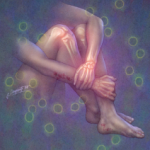
Dr. Pisetsky
In the view of these researchers, lupus is not confounded by such conditions as fatigue or fibromyalgia, they are part of it, according to Dr. Pisetsky. Thus, they created a scheme that includes them as a fundamental aspect of the disease.
“In a sense, we are repositioning where we place these symptoms in the scheme of disease, but I think the importance is to recognize that they are really part of lupus,” he says.
The disease model proposed by the Duke team includes symptoms “in a more unified way,” incorporating as essential features of lupus those conditions that are typically considered comorbidities. It helps get around the problem when a patient says “my lupus is active” but lab results don’t show it, says Dr. Pisetsky.
The collaboration of lupus researchers and clinicians at Duke came about by listening to patients speak about their problems and acknowledging that very often their symptoms were not considered disease activity even though they posed major problems for the patient.
“That led us to this idea that these symptoms, what we now call type 2, are very much part of lupus,” says Dr. Pisetsky. “They’re not just incidental. They’re not coincidental. They are part of lupus, but they do not easily fit into the usual scheme—looking at disease activity or looking at damage.
“What we did is to try to come up with a model that incorporates both types, signs and symptoms in a common framework to evaluate patients.”
Type 1 & Type 2 Mix
It is not unusual for lupus patients to experience symptoms that fall into both categories or vary between the two types at different times of active disease, explains Dr. Pisetsky.
“The likelihood, and what our data suggest, is that patients have mixtures of symptoms; some have a significant number of type 1 problems but don’t have very many type 2. Other patients have many more type 2 issues, but don’t have a lot of type 1,” says Dr. Pisetsky.
A clinical evaluation can identify whether a patient is one type or the other, or has mixed activity from both types.
“For example, a patient with SLE may have low disease activity or even disease in remission in terms of type 1 manifestations and associated biomarkers; nevertheless, that patient may experience severe type 2 manifestations and be limited by unrelenting pain and fatigue,” states the article.

